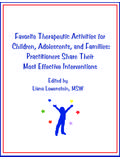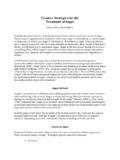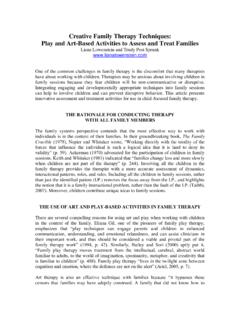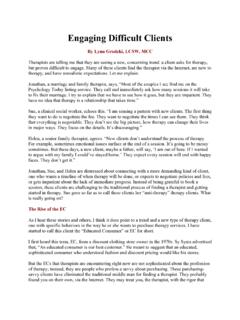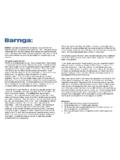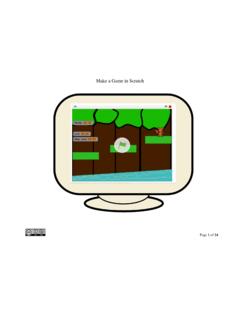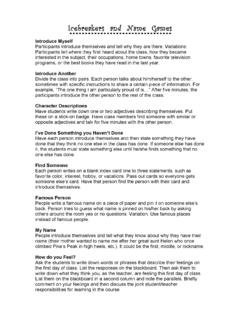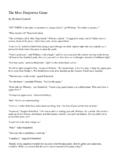Transcription of Game-Based Cognitive-Behavioral Therapy: A Model for ...
1 Game-Based Cognitive-Behavioral therapy : A Model for Treating Elementary School Aged Survivors of Child Sexual Abuse Craig Springer & Justin R. Misurell Game-Based Cognitive-Behavioral therapy (GB-CBT) is an integration of two major theoretical approaches, Cognitive-Behavioral therapy and play therapy (Springer & Misurell, 2010; Springer & Misurell, 2012). Research on cognitive behavioral therapy (CBT) has identified effective techniques and principles for treating childhood anxiety and trauma (Barlow, 2002; Foa, Hembree, & Rothbaum, 2007; Kendall & Hedtke, 2006).
2 Among these are the use of a directive style, present focused orientation, skills- based practice and systematic desensitization of clients to anxiety-related cues. Additionally, literature examining Trauma-Focused- cognitive behavioral therapy (TF-CBT), the most extensively researched treatment for survivors of child trauma, has highlighted a number of critical therapeutic components including emotional identification, expression and regulation skills, knowledge about abuse, gradual exposure to abuse-specific stimuli and coping and personal safety skills (Briggs, Runyon, & Deblinger, 2011; Cohen, Deblinger, Mannarino, & Steer, 2004; Cohen, Mannarino, & Deblinger, 2006).
3 Practitioners in the field have extensively utilized play therapy techniques to address childhood difficulties as a means of building rapport, engaging children in treatment and communicating with children through their natural mode of expression (Schaefer & Drewes, 2009). In an edited volume (Drewes, 2009) authors discuss the utility of integrating CBT and play therapy for treating a variety of childhood problems. More recently, play therapy techniques have specifically been discussed in their application for delivering TF-CBT for victims of trauma (Cavett & Drewes, 2012; Drewes & Cavett, 2012).
4 GB-CBT integrates the major tenants of the CBT and play therapy approaches into a manualized curriculum, combining behavioral techniques such as token economies, role-plays and psychoeducation with structured play. This approach allows clinicians to establish a therapeutic environment, which promotes skill development, minimizes behavioral difficulties, and provides a positive, pleasant and motivating atmosphere. GB-CBT is based on four core principles: 1) Data driven; 2) Directive and structured; 3) Experiential learning; 4) Fun and engaging. GB-CBT is data driven in that its development was largely influenced by research outlining effective behavioral strategies and techniques for addressing childhood difficulties and childhood trauma.
5 Additionally, behavioral measures and weekly feedback are used to inform and guide treatment planning and assess progress. GB-CBT clinicians adopt a directive and structured approach to treatment, utilizing a manual containing topical areas with a menu of games and activities and outlines for conducting sessions. The components covered in GB-CBT are rapport building, personal space, emotional expression skills, linking feelings to experiences, anger management, relaxation training, child abuse education, abuse processing, personal safety skills, and termination processing.
6 behavioral expectations, session goals and incentives are explicitly presented to clients. Within the context of GB-CBT, clients acquire skills through experiential learning. This requires clients to take an active role in the learning process, provides opportunities for practicing and rehearsing skills and allows for clients to receive corrective feedback. Finally, GB-CBT uses techniques that are fun and engaging in order to motivate client participation and reduce resistance. GB-CBT is primarily delivered through the use of developmentally appropriate games (DAGs; Reddy, Spencer, Hall & Rubel, 2001; Reddy, Springer, Files-Hall, Benisz, Braunstein, Hauch & Atamanoff, 2005).
7 The formats of these games include competitions, collaborative play, races, card games and board games . These games are used in a manner that strives to take into account client s interests, preferences, beliefs and abilities (Misurell & Springer, 2011; Springer & Misurell, 2012). GB-CBT is administered in both group and individual therapy formats, where skills are presented in a specific order, which build upon each other. The GB-CBT group Model is typically delivered in twelve 90-minute weekly sessions and covers a fixed sequence. Each session begins with a group structure, highlighting behavioral expectations, token economies, and bathroom and time out procedures.
8 This is followed by psychoeducation about the topic of the day, session role plays and DAGs, group processing, behavioral evaluation and reward distribution. A concurrent non-offending caregiver group is offered, also containing DAGs, to provide caregivers with parallel skill development, parenting education, and opportunities to heal from their children s trauma. This enables caregivers to support their children through treatment and to better provide for their overall needs. The GB-CBT individual Model involves working with the child and non-offending caregiver and is typically administered in 10-16, 90-minute sessions.
9 The individual Model uses a modular approach providing an ability to tailor the sequence of skills presented and amount of time spent on each topic to fit the individualized needs of the client. Each session usually begins with a meeting with the child s caregiver, during which behavioral problems and symptoms are assessed, session skills are discussed and games are presented. Next, the clinician meets individually with the child to review behavioral expectations and incentives, discuss skills taught during the previous session, provide psychoeducation regarding topic(s) of the day and present and play therapeutic games .
10 The session continues with a conjoint meeting with the child and caregiver. During this time, the caregiver, child and clinician review session skills and play session games together. The session concludes with processing the activities, assessing behavioral performance and awarding incentives. Initial treatment outcome studies found that GB-CBT effectively addresses posttraumatic symptoms ( , recurrent thoughts, flashbacks, etc.), anxiety, depression, sexually inappropriate behaviors, and externalizing behavioral problems ( , inattention, hyperactivity, aggression, oppositionality; Misurell, Springer, Acosta, Liotta, & Kranzler, in press; Misurell, Springer, & Tryon, 2011).

